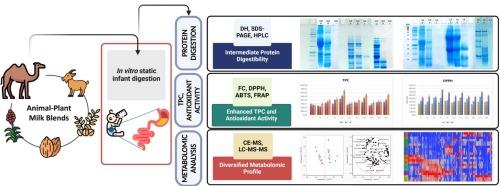Effect of Hybrid Animal-Plant Milk Blends on Metabolomic Profiles, Antioxidant Capacities, and Protein Digestibility for Potential Infant Nutrition Applications
IF 9.8
1区 农林科学
Q1 CHEMISTRY, APPLIED
引用次数: 0
Abstract
This study investigates the digestibility, antioxidant capacity, total phenolic content (TPC) and the release of different metabolites from blended animal (camel and goat) and plant (oat, quinoa, almond) milks upon simulated infant static in vitro digestion. The study indicated that blending produced intermediate protein digestibility alongside enhanced release of bioactive compounds, heightened antioxidant potential, and richer metabolite diversity. Notably, camel-quinoa and goat-quinoa blends stood out for their elevated phenolic levels, robust antioxidant activity, and well-rounded post-digestion metabolite composition, whereas camel-almond exhibited a uniquely balanced amino acid and sugar profile. Metabolomic analysis further revealed that blended milk samples demonstrated higher capacities to activate pathways associated with amino acid biosynthesis and carbohydrate metabolism, suggesting their potential to address nutritional gaps in single-source formulations by creating nutritionally optimized infant formulas. While initial findings are encouraging, further research is crucial to meticulously refine these milk blends as base ingredients, ensuring optimal infant health.


动植物混合乳对代谢组学、抗氧化能力和蛋白质消化率的影响,可用于潜在的婴儿营养应用
本研究研究了动物(骆驼和山羊)和植物(燕麦、藜麦、杏仁)混合奶在模拟婴儿静态体外消化条件下的消化率、抗氧化能力、总酚含量(TPC)和不同代谢物的释放。该研究表明,混合可以提高中间蛋白质的消化率,同时增强生物活性化合物的释放,提高抗氧化潜力,并丰富代谢物的多样性。值得注意的是,骆驼藜麦和山羊藜麦混合物以其高酚含量、强大的抗氧化活性和全面的消化后代谢物组成而突出,而骆驼杏仁则表现出独特的平衡氨基酸和糖谱。代谢组学分析进一步显示,混合奶样品显示出更高的激活氨基酸生物合成和碳水化合物代谢相关途径的能力,这表明它们有可能通过制造营养优化的婴儿配方奶粉来解决单一来源配方奶粉的营养缺口。虽然最初的发现令人鼓舞,但进一步的研究对于精心提炼这些混合牛奶作为基础成分,确保婴儿的最佳健康至关重要。
本文章由计算机程序翻译,如有差异,请以英文原文为准。
求助全文
约1分钟内获得全文
求助全文
来源期刊

Food Chemistry
工程技术-食品科技
CiteScore
16.30
自引率
10.20%
发文量
3130
审稿时长
122 days
期刊介绍:
Food Chemistry publishes original research papers dealing with the advancement of the chemistry and biochemistry of foods or the analytical methods/ approach used. All papers should focus on the novelty of the research carried out.
 求助内容:
求助内容: 应助结果提醒方式:
应助结果提醒方式:


